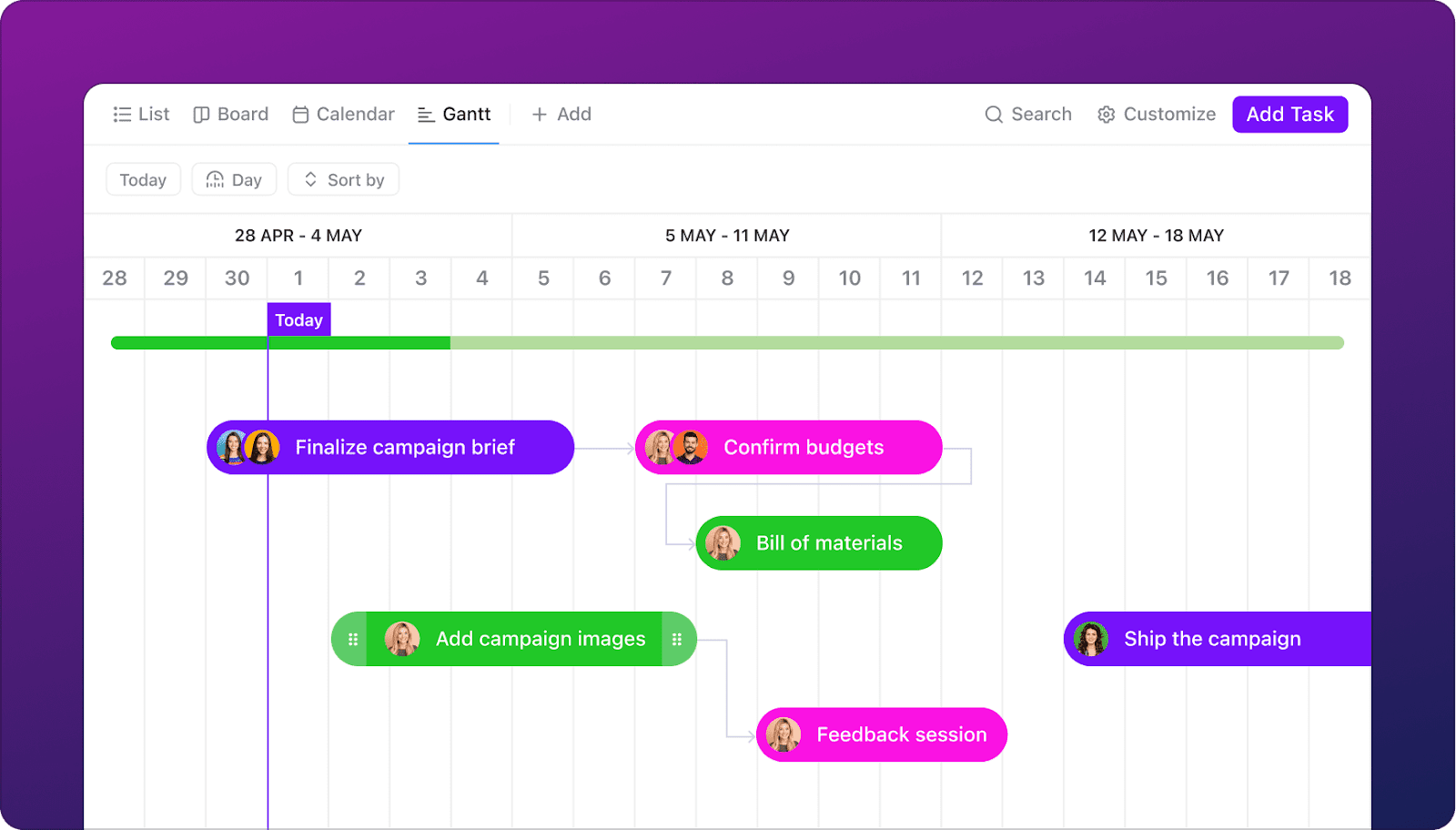Database management has evolved far beyond its humble beginnings as a straightforward combination of storage and development. It includes intricate coding, retrieval logic, and real-time organization, making databases more powerful, versatile, and complex than ever!
The market for database management systems is expected to grow at a CAGR of 13.1% by 2030. With so much at stake, selecting the right database software has become a critical decision that demands thorough research and consideration!
While there are many options, identifying the ideal solution could be overwhelming, especially when exploring free options.
To simplify your search, we’ve done the heavy lifting. This blog presents a carefully curated list of the 13 top free database software solutions to help you store and manage data! ✅
Let’s begin!
⏰ 60-Second Summary
- (Best for database and workflow management)
- MongoDB (Best for modern application development)
- MySQL (Best for open-source relational databases)
- Microsoft SQL Server (Best for enterprise-level database solutions)
- Amazon RDS (Best for managed cloud database services)
- Airtable (Best for no-code database simplicity and collaboration)
- PostgreSQL (Best for advanced SQL compliance and extensibility)
- MariaDB (Best for scalability and flexibility)
- Altibase (Best for hybrid in-memory and disk-resident databases)
- Apache Cassandra (Best for focusing on mission-critical applications)
- Oracle (Best for distributed database software)
- IBM Db2 (Best for AI-powered analytics and data integration)
- DbVisualizer (Best for visual-focused database management)
What Is Database Software?
Database software is your digital librarian. It is a specialized application designed to efficiently create, organize, store, retrieve, and manage data in a structured format. Whether running a business or developing an app, effective database tools keep your data chaos-free.
At its core, database software enables the interaction between users, applications, and data through an intuitive interface or programmatic access, such as queries. Modern database software often incorporates advanced features like data analytics, real-time processing, and scalability to adapt to small-scale projects and enterprise-level demands.
Here are the common types of database software that are in use today:
- Relational database: Organizes data in structured tables. Relational databases are ideal for establishing relationships between data points and ease of querying
- NoSQL database: Handles unstructured or semi-structured data. It is best suited for flexibility in managing diverse and large datasets
- Cloud-based database: Designed to offer scalability and remote accessibility. Supports distributed teams and dynamic storage needs quite well
- Graph database: Stores data as nodes and relationships. This is great for analyzing complex relationships like social networks or supply chains
- In-memory database: Processes data directly in memory. These databases are best used for fast performance in real-time applications
🔎 Did You Know? Database management was first developed by an English scientist at IBM named Edgar F. ‘Ted’ Codd!
The right database software unlocks a treasure trove of benefits. Here are a few reasons to help you discover why it’s a game-changer:
- Eliminates data duplication: Keeps your information clean and organized ✅
- Boosts productivity: Speeds up data access and management ✅
- Establishes data security: Protects sensitive information with powerful safeguards ✅
- Delivers valuable insights: Helps businesses make data-driven decisions ✅
- Supports scalability: Grows seamlessly with your organization ✅
- Offers versatility: Meets diverse needs, from developers to enterprises ✅
- Essential for data management: A critical tool for managing and optimizing data ✅
What Should You Look for in the Best Free Database Software?
Here are six key aspects essential for any effective database software:
- 📶 Seamless scalability: Choose database software that grows with your business.
This is a vital part of planning to increase data, operations, and users without disruptions - 🔗 Integration compatibility: Pick database solutions that integrate easily with your existing tools and platforms. Integration saves time and effort, streamlining workflows across systems
- 🔐 Strong data security: Opt for multi-layer encryption and access controls to protect sensitive data. Reliable security features prevent data breaches and drive regulatory compliance
- 😎 User-friendly interface: Pick a database software with an intuitive interface and support resources. Ease of use reduces the learning curve, helping teams adapt quickly and work efficiently
- 💯 Performance focus: Focus on free database software with speed and reliability under heavy data loads. Fast database solutions minimize downtime, improving overall productivity and user satisfaction
- 📊 Analytical capabilities: Select a system that generates actionable insights from your data. Empower smarter decision-making with comprehensive analytical tools
The Top 13 Best Free Database Software For You
Here are the top 13 best database software solutions for your database requirements:
1. (Best for database and workflow management)
is the everything app for work that combines project management, knowledge management, and team communication, all in one platform—accelerated by next-generation AI automation and search.
It excels in database and workflow management. While traditionally known for task and project management, offers unique database functionalities that empower teams to centralize their data and optimize operations.
With flexible views, pre-designed templates, and seamless integration between data and tasks, makes database management accessible to all users, regardless of technical expertise.
enables users to create and manage databases using its List View, Table View, or even as part of ’s CRM.
The List View offers a simple yet structured way to organize information with customizable fields for tracking anything from contacts to project milestones. For a more spreadsheet-like experience, the Table View provides a familiar layout, perfect for managing big datasets, such as sales pipelines or inventory.
Additionally, businesses use ’s CRM capabilities to manage client relationships and integrate and track customer data seamlessly with task management workflows to act as customer database software.
The extensive template library available within further enhances its database capabilities.
Whether you need to create a client database, a content calendar, or a product inventory, start with a pre-designed database template tailored to your needs. These customizable spreadsheet templates allow teams to add fields, relationships, and automations to suit specific workflows.
Automations takes database management to the next level by reducing manual work. Automate tasks like updating statuses, assigning owners, or notifying team members when specific conditions are met.
How does it work? A database tracking leads triggers automation to alert sales teams when a lead progresses to the next stage so that nothing slips through the cracks.
also offers effortless integration of tasks and data management. Using Tasks, database entries are directly tied to actionable tasks, enabling teams to manage projects and their associated data in one place. For instance, a database of marketing campaigns includes tasks, deadlines, and responsible team members, all visible and manageable within the same workspace.
Such integration ensures data remains actionable, improving collaboration and operational efficiency. With task management, progress tracking, collaboration, and information flow, has become an ideal workflow software.
best features
- Set up a document database, map processes, collaboratively establish data protocols, and share content with Docs
- Capture ideas, automate tasks, and generate summaries from your database with Brain
- Visualize performance, derive analytical insights, and generate real-time reports with Dashboards
- Connect workflows, larger databases, and external tools with over 1000+ Integrations
limitations
- May require a longer learning curve to master its comprehensive features
pricing
- Free Forever
- Unlimited: $7/month per user
- Business: $12/month per user
- Enterprise: Contact for pricing
- Brain: Add to any paid plan for $7/month per user
ratings and reviews
- G2: 4.7/5 (9,000+ reviews)
- Capterra: 4.6/5 (4,000+ reviews)
2. MongoDB (Best for modern application development)
MongoDB is a leading open-source NoSQL database that is used for its flexibility and scalability.
Unlike traditional relational databases, MongoDB employs a document-oriented data model. This schema-less document database design allows for dynamic and hierarchical data structures, making it particularly advantageous for applications that handle diverse and evolving datasets.
MongoDB’s distributed architecture ensures high availability and horizontal scalability, enabling seamless data distribution across multiple servers. These attributes have led to widespread adoption in various sectors, including e-commerce, content management, and real-time analytics.
MongoDB best features
- Get flexible data retrieval without predefined schema through dynamic queries that use a document-based query language
- Enhance query performance with comprehensive indexing on fields within documents to enhance query performance
- Distribute data across multiple servers using a shard key, encouraging horizontal scalability and balanced workloads
MongoDB limitations
- Cannot efficiently execute complex transactions compared to other relational databases
- Consumes more memory with large datasets, impacting performance
MongoDB pricing
- Shared: Free
- Dedicated: Starts at $0.08/hour per 2 virtual CPUs
- Serverless: Starts at $0.10 per 1 million read and scan operations
- Enterprise: Custom pricing
MongoDB ratings and reviews
- G2: 4.5/5 (500+ reviews)
- Capterra: 4.7/5 (450+ reviews)
3. MySQL (Best for open-source relational databases)
MySQL is an open-source relational database management system (RDBMS) that utilizes Structured Query Language (SQL) for efficient data management. Developed in the mid-1990s, it has become one of the most widely used database systems globally, powering many applications from small-scale projects to large enterprise solutions.
MySQL’s architecture is developed for speed and reliability, making it a preferred choice for web applications, data warehousing, and e-commerce platforms. Its cross-platform support and compatibility with various programming languages enhance its versatility in diverse development environments.
A significant advantage of MySQL is its dual licensing model, offering a free, open-source edition under the GNU General Public License (GPL) and commercial versions with additional features and support.
MySQL best features
- Maintain data consistency with ACID-compliant transactions
- Deliver fast query performance, especially for read-heavy applications
- Automate routine database operations by scheduling tasks to run at specific times or intervals
MySQL limitations
- Lacks native support for full-text search in some configurations
- Requires manual tuning for optimal performance under heavy workloads
MySQL pricing
- Open source and free to use
MySQL ratings and reviews
- G2: 4.4/5 (1,600+ reviews)
- Capterra: 4.6/5 (2,000+ reviews)
4. Microsoft SQL Server (Best for enterprise-level database solutions)
Microsoft SQL Server is a powerful relational database software developed and designed to handle various enterprise-grade data management and analysis needs. With its extensive capabilities, the database software caters to a diverse audience, from developers and database administrators to data scientists, providing tools and features for every stage of the data lifecycle.
This database solution is optimized for transactional processing and business intelligence (BI) applications. It offers a highly scalable architecture that supports everything from small, single-server environments to large, distributed enterprise systems.
SQL Server stands out for its seamless integration with the Microsoft ecosystem, including Azure, Power BI, and Visual Studio.
Microsoft SQL Server best features
- Protect sensitive data with role-based access control and the Always Encrypted technology
- Get minimal downtime and disaster recovery across multiple nodes with Always On Availability Groups
- Incorporate SQL Server Integration Services (SSIS), Reporting Services (SSRS), and Analysis Services (SSAS) for end-to-end business intelligence solutions
Microsoft SQL Server limitations
Microsoft SQL Server pricing
- Free Developer Plan
- Other plans start from $73/month per user
Microsoft SQL Server ratings and reviews
- G2: 4.4/5 (2,200+ reviews)
- Capterra: 4.6/5 (1,900+ reviews)
5. Amazon RDS (Best for managed cloud database services)
Amazon Relational Database Service (RDS) is a managed cloud-based solution that simplifies relational databases’ setup, operation, and scaling. Amazon RDS transforms database management by streamlining routine tasks like provisioning, configuration, backup, and patching. Imagine spinning up a new database in minutes—it’s that easy!
RDS supports multiple database engines, including Amazon Aurora, PostgreSQL, MySQL, MariaDB, Oracle, and Microsoft SQL Server, and offers flexibility to accommodate diverse application requirements.
Designed for high availability and durability, Amazon RDS also provides unique Multi-AZ (Availability Zone) deployments. These create synchronous standby replicas of data across different database zones to ensure data redundancy and minimize downtime during maintenance or unexpected failures.
Amazon RDS best features
- Enhance data protection through automated backups and provisions to create snapshots for point-in-time recovery
- Create read-only replicas to distribute read traffic and improve performance for read-intensive applications
- Get real-time metrics and alerts by integrating with Amazon CloudWatch
Amazon RDS limitations
- Costs increase quite a lot with database operations and storage requirements
- Offers limited customization options compared to self-managed databases
Amazon RDS pricing
- AWS Free Tier: No charge access for 12 months
- Pricing by Amazon RDS engine: Contact sales for pricing
- Pricing by Amazon RDS deployment: Contact sales for pricing
Amazon RDS ratings and reviews
- G2: 4.5/5 (1,000+ reviews)
- Capterra: 4.7/5 (200+ reviews)
6. Airtable (Best for no-code database simplicity and collaboration)
Airtable is a cloud-based collaboration and database software that combines the simplicity of a spreadsheet with the power of a relational database. It empowers users to organize, track, and manage data through an intuitive and highly customizable interface.
Unlike traditional databases, Airtable requires no coding expertise. This makes it accessible to individuals and teams across various industries, including marketing, project management, content creation, and event planning.
It also has a unique approach, allowing users to structure data to best suit their needs. It offers unparalleled flexibility through linked records, relational tables, or color-coded tags.
Airtable best features
- Jumpstart your projects with a variety of templates that cater to different use cases and industries
- Promote efficient teamwork with multiple users working simultaneously, with changes reflected instantly
- Create custom workflows tailored to specific project requirements
Airtable limitations
- Limited scalability for large datasets and complex queries.
- Gets costly when you opt for advanced features and have larger teams
Airtable pricing
- Free
- Team: $24/month per seat
- Business: $54/month per seat
- Enterprise Scale: Custom pricing
Airtable ratings and reviews
- G2: 4.6/5 (2,600+ reviews)
- Capterra: 4.7/5 (2,100+ reviews)
7. PostgreSQL (Best for advanced SQL compliance and extensibility)
PostgreSQL is a powerful, open-source database management system with over 35 years of active development. It supports various data types and advanced functionalities, making it suitable for various applications, from small projects to large-scale enterprise solutions.
PostgreSQL’s compliance with SQL standards and support for ACID transactions ensure data integrity and reliability. The software also has various applications, including gaming apps, database automation tools, and domain registrations.
Furthermore, PostgreSQL supports advanced data types and performance optimization features.
PostgreSQL best features
- Optimize query performance across diverse data sets through various indexing methods
- Support complex querying and ranking with built-in capabilities for efficient text search within large datasets
- Use the PostGIS extension that offers geographical object support for location-based services and geographic information system (GIS)
PostgreSQL limitations
- Requires more technical expertise for configuration and management
- Does not scale as easily for cloud-native applications
PostgreSQL pricing
- Open-source and free
- Add-ons and integrations may require purchase
PostgreSQL ratings and reviews
- G2: 4.4/5 (630+ reviews)
- Capterra: 4.6/5 (410+ reviews)
8. MariaDB (Best for scalability and flexibility)
MariaDB is an open-source relational database management system (RDBMS) that originated as a fork of MySQL in 2009. It has since evolved with distinct features and enhancements, making it a popular choice for developers and enterprises seeking a foolproof and flexible database solution.
MariaDB also integrates with various tools, comes with an active open-source community, and regular updates. The database software maintains compatibility with MySQL, providing seamless migrations while introducing unique functionalities that cater to modern data management requirements.
MariaDB best features
- Tailor database performance and capabilities to specific application need through different supported storage engines like Aria, InnDB, XtraDB, and MyRocks
- Improve database security through enhancements such as user roles, password validation plugins, and data-at-rest encryption
- Optimizes your database performance with extensive, open-source customization options
MariaDB limitations
- Requires monitoring as scalability sometimes leads to resource strain
- Limits graphical interfaces with fewer built-in visualization tools
MariaDB pricing
- MariaDB Community: Open source and free
- MariaDB Enterprise: Custom pricing
MariaDB ratings and reviews
- G2: 4.4/5 (220+ reviews)
- Capterra: 4.7/5 (70+ reviews)
9. Altibase (Best for hybrid in-memory and disk-resident databases)
Whether you need lightning-fast data processing or secure long-term storage, Altibase delivers the best of both worlds.
Global enterprises use this high-performance relational database management system (RDBMS), uniquely combining in-memory and disk-resident storage within a single unified engine. Plus, the hybrid architecture optimizes speed without sacrificing reliability.
With seamless scaling and exceptional transaction processing features, Altibase is a top pick for dynamic, data-heavy environments. It also supports real-time analytics and concurrent data handling for smooth operations. Plus, its in-memory features always deliver irrespective of peak loads.
Altibase best features
- Conduct reliable transaction processing and integration with existing systems due to Altibase being ANSI SQL and ACID compliant
- Ensures data operations continuity with multiple built-in failover mechanisms
- Supports large-scale deployments with multi-node clustering capabilities
Altibase limitations
- Demands an advanced setup to utilize its hybrid architecture fully
- Lacks wide third-party integration compared to more popular databases
Altibase pricing
Altibase ratings and reviews
- G2: Not enough reviews
- Capterra: Not enough reviews
10. Apache Cassandra (Best for focusing on mission-critical applications)
Apache Cassandra is a free database software recognized for its exceptional scalability and high availability.
An open-source NoSQL database system, Cassandra is designed to handle large volumes of data across multiple commodity servers without a single point of failure. This makes it ideal for applications requiring higher-end performance and continuous uptime. Whether you handle massive data volumes or need zero downtime in database systems, Cassandra delivers reliability like no other.
Its decentralized architecture ensures data redundancy and fault tolerance, making it a preferred choice for industries managing extensive datasets and demanding real-time analytics.
Apache Cassandra best features
- Get the flexibility to balance between consistency and availability based on application requirements
- Simplify interactions for developers within database systems with the Cassandra Query Language (CQL), a SQL-like language
- Ensure data availability and reliability across geographically distributed locations through distributed data storage and replication
Apache Cassandra limitations
- Limited ACID (Atomicity, Consistency, Isolation, Durability) compliance is a drawback for applications requiring strict transactional integrity
- Lacks built-in analytics capabilities, requiring external tools for analysis
Apache Cassandra pricing
- Software is open source and free
Apache Cassandra ratings and reviews
- G2: 4.1/5 (30+ reviews)
- Capterra: 4.2/5 (30+ reviews)
11. Oracle (Best for distributed database software)
Oracle Database is a comprehensive and widely adopted relational database management system (RDBMS) known for its scalability, reliability, and rich feature set.
With the blend of architecture and advanced AI analytics, this database caters to various applications, from small-scale operations to large enterprise systems, providing efficient data management and support for complex transactions.
The advanced security measures and high availability solutions in Oracle Database secure data integrity and continuous operation, making it a preferred choice across various industries. Powerful features, like real-time data replication and multi-cloud compatibility, ensure peak performance across global operations.
Oracle best features
- Get high availability and scalability without requiring changes to applications due to multiple servers to operate as a single system with the Real Application Clusters (RAC) feature
- Manage spatial and graph data through advanced capabilities that support complex geospatial applications and network data models
- Simplify database storage management by automating data striping and mirroring
Oracle limitations
- The licensing is complicated and costly, especially for small to medium-sized enterprises
- Demands skilled expertise and a dedicated team for configuration and optimization
Oracle pricing
Oracle ratings and reviews
- G2: 4.3/5 (940+ reviews)
- Capterra: 4.6/5 (460+ reviews)
12. IBM Db2 (Best for AI-powered analytics and data integration)
If you’re after the perfect mix of AI smarts and seamless database optimization, pick IBM Db2. This relational database management system uses machine learning algorithms to simplify data retrieval and turn it into actionable insights.
Renowned for its stability and scalability, Db2 is widely adopted in finance, healthcare, and retail industries, where data integrity and performance are critical. Its advanced data compression and self-tuning capabilities enhance efficiency, making it a reliable choice for enterprises managing extensive datasets.
In short, IBM Db2 isn’t just about keeping things running; it’s about running smarter.
IBM Db2 best features
- Get faster analytics and reporting through in-memory computing with the BLU Acceleration feature
- Secure data availability through IBM’s built-in data recovery solution called the High Availability Disaster Recovery (HADR)
- Improve query performance and reduce storage requirements with advanced data compression
IBM Db2 limitations
- The pricing structure is complex, potentially leading to higher costs for certain deployments
- Demands substantial hardware investment and maintenance for optimal performance
IBM Db2 pricing
- Free
- Standard: $99/month (billed hourly, two virtual CPUs)
- Enterprise: $969/month (billed hourly, four virtual CPUs)
IBM Db2 ratings and reviews
- G2: 4.1/5 (650+ reviews)
- Capterra: 4.4/5 (50+ reviews)
13. DbVisualizer (Best for visual-focused database management)
DbVisualizer is a top database management tool emphasising visual clarity and user-friendly features. Its intuitive interface simplifies complex database operations by turning intricate data structures into easily digestible visual representations.
Whether you’re running queries or analyzing datasets, DbVisualizer makes database management effortless with its visual query builder and real-time data visualization. Designed for flexibility, it supports and integrates with various platforms, including the MySQL database and NoSQL extensions.
Its intuitive navigation and organized layout also help new developers and seasoned experts efficiently explore and manage data workflows.
DbVisualizer best features
- Visualize complex relationships with customizable charts and diagrams, making interpreting data easier
- Get the flexibility of operating seamlessly in different environments like Windows, macOS, and Linux/UNIX systems
- Optimizes query management with advanced syntax highlighting, auto-completion, and visual query-building tools
DbVisualizer limitations
- Limited advanced automation features compared to other enterprise-grade tools
- Users experience performance slowdowns when handling large databases
DbVisualizer pricing
- Free
- Pro (limited support): $197/year per user for the first year and $69/year per user from the second year onwards
- Pro (premium support): $229/year per user for the first year and $99/year per user from the second year onwards
DbVisualizer ratings and reviews
- G2: 4.7/5 (200+ reviews)
- Capterra: 4.8/5 (100+ reviews)
Optimize Database Management with
With the rise in data volumes and the demand for actionable insights, database management software plays a vital role across businesses and industries.
Our list of the 13 best free database software options provides effective solutions tailored to diverse needs. However, stands out from the competition. ✅
goes beyond traditional database management by combining advanced AI, powerful automation, seamless integrations, and task management into one unified platform. With features like pre-designed templates to minimize manual effort without compromising quality, improves how you manage and utilize your data.
Sign up with today and optimize your databases!


Everything you need to stay organized and get work done.







.jpg)




